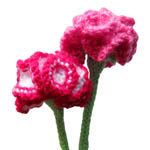February 2013
Does February count as spring or is it still part of winter? Either way I've decided to do my spring clean. A first one anyway. I'll almost certainly give up halfway through and have to start again in March.
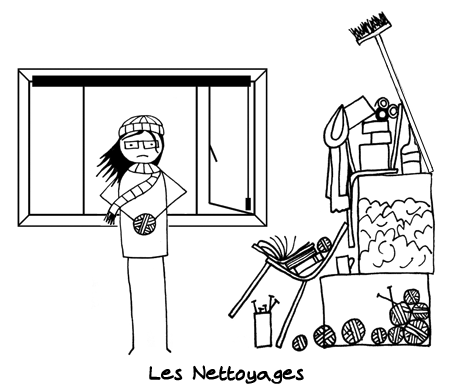
My preferred method is to pile up everything on the floor, then slowly sort it back into place on dust free shelves. This year I may have found myself stacking things higher than usual while singing about blood of angry men and hearing the people sing. Cinema is a bad influence.
(Sorry if the title of the cartoon doesn't make sense. I did six weeks of French around 1996 so don't judge me too harshly!)
04/03/2013
And Done
The carnation pattern is available. Just thought I'd write that on here as I completely forgot to mention it at the time. Oh well.
24/02/2013
Carnation Watch
My carnations are just starting to edge open and I've been examining them closely.

The top of the green bit either has five or six points (usually five on mine). The spiky bits at the bottom come in many layers of two. The leaves also come in pairs and it is at joins with the leaves that the stem often splits in two.
The question was which of these details to leave out of my design. I have decided not to include all the pairs of leaves (for now, I may do a pattern update for them later), or the tendency of the stem to split.
22/02/2013
Hyperbolic Plane on a Stick (Part III)
So this month's pattern is going to be a carnation and my carnation is basically a hyperbolic plane on a stick (told you we'd get back to flowers).
During the week I've been knitting the flower part of the pattern. I decided on a tight decrease to make the flower densely ruffled. Attempt one was in pink.
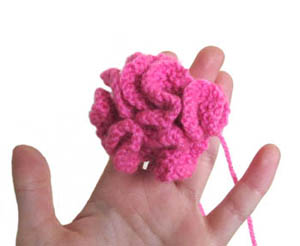
I'm happy with it. The only downside is it looks slightly like brains.
My second attempt I used pink to cast on and white to knit, like a variegated breed of carnation. Much less brain like.
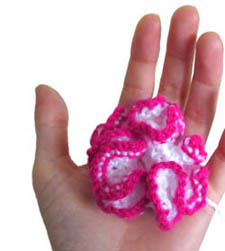
At this point I hit a snag because I was unsure what the sepals of a carnation looked like. Since carnations are cheap and cheerful I picked up some at the local supermarket, but I'm still not sure how the sepals connect to the flower because at the moment mine look like this.

15/02/2013
Hyperbolic Plane on a Stick (Part II)
So my first attempt at a hyperbolic plane did get a bit fiddly. Also it just wasn't very pretty. This is always a big concern for me. I can use maths to work out designs, but making them attractive takes thought, time and effort. I finally got around to having another try.
For my second attempt I wanted to make the knitting less fiddly. Reducing the increase would help (I was originally increasing 1 stitch for every 2 knitted). But the stitches would still be squeezed together as their number increased. I decided to come at the problem from a different direction. If I cast on lots of stitches (about 400 in the end) and decreased by 1 stitch for every 12 worked the knitting would be much more manageable.
Now for the pretty. My first attempt was knitted in stocking stitch which made the fabric curl more than I wanted. For my second attempt I decided to use garter stitch. I also decided to consider every two rows of garter stitch as a single entity, a unit of pattern that makes a ridge on each side of the fabric. Practically this means that the decreases happen on the odd rows and even rows are knitted plain. The idea was to make the fabric more even.
The second attempt came out better, if I do say so myself.
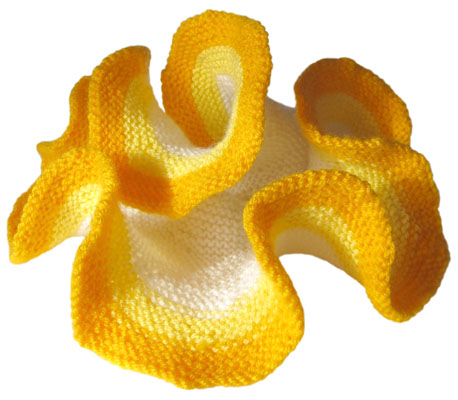
It's a strangely organic shape isn't it. I'm not the only one to think so either. Hyperbolic crochet is the main building block for Crochet Coral Reefs which are absolutely stunning.
It could have been influenced by the colours I used, but my first thought wasn't coral, it was FLOWER! Specifically: CARNATION! Ever since I've wanted to do a knitting pattern for a carnation that was basically a hyperbolic plane on a stick.
12/02/2013
Hyperbolic Plane on a Stick (Part I)
This will all lead back to flowers eventually, I promise...
The year before last at my family's SEOS event I was knitting quietly in a corner when a visitor struck up a conversation about my knitting. We spoke about how relevant maths was to pattern design and he recommended a book, Alex's Adventures in Numberland (Alex Bellos), because it had a chapter discussing how hyperbolic planes could be modelled with crochet.
The models created were beautiful, curvy shapes. Check out the gallery at The Institute for Figuring for examples.
I can't crochet, but how could I ignore mathematically inclined yarn craft? I found another book, by the creator of the models: Crocheting Adventures with Hyperbolic Planes (Daina Taimina).
So, first question, what IS a hyperbolic plane? I vaguely remembered this from the introduction to a physics lecture...
If you draw a triangle on a flat piece of paper the angles of the points will add up to 180°. It's easy to test this yourself – cut out any triangle from a piece of paper, rip off the corners and arrange the points together. They'll make a straight line. Always. A straight line is an angle of 180°.

This isn't true for all types of surface. Draw a triangle on a sphere and the angles will add up to more than 180°. In fact it's possible to draw a triangle with three right-angles! Find an orange and a marker pen and you can test this yourself. Draw a triangle, tear out the corners, line them up and they won't make a straight line.
A sphere is an example of a surface that has positive curvature. A hyperbolic plane is the opposite. It has negative curvature. If you draw a triangle on a hyperbolic plane the angles will add up to less than 180°. Still can't picture the surface? Well according to the book that's exactly what inspired Daina Taimina to make crochet models.
The basic technique she uses is to crochet a surface outwards from a point or a line. In each row you increase the number of stitches by the same ratio (e.g. add one extra stitch for every n stitches in the previous row). Sounds like you could do the same with knitting doesn't it. Working round and round or back and forth, increasing 1 stitch for every n you work. The more you increase (the smaller n is) the more the surface distorts.
One section of the book stuck out to me:
First, I tried to knit since I am an avid knitter. But the number of stitches on the needles soon became unmanageable...
CHALLENGE ACCEPTED.
Which is why this happened...
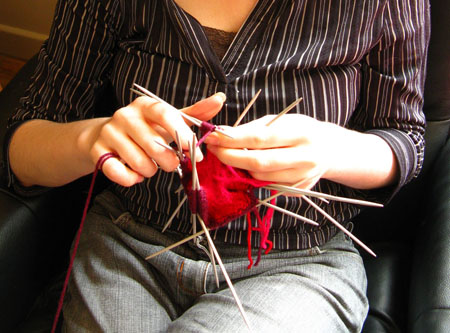
I won't admit that the number of stitches became unmanageable, but I did have to space them out onto more and more needles. Once I had 48 needles on the go I began to run out of similarly sized dpns.
To Be Continued...
08/02/2013
Fleurs
I think it's time to knit some more flowers. I have an idea on how to make carnations, and calla lilies have a wonderful shape. Time to do some reseach and sketches.
© 2013 All desgins and images are copyright of ODDknit. If you enjoy the content of this website, please consider buying me a coffee at the link below.
